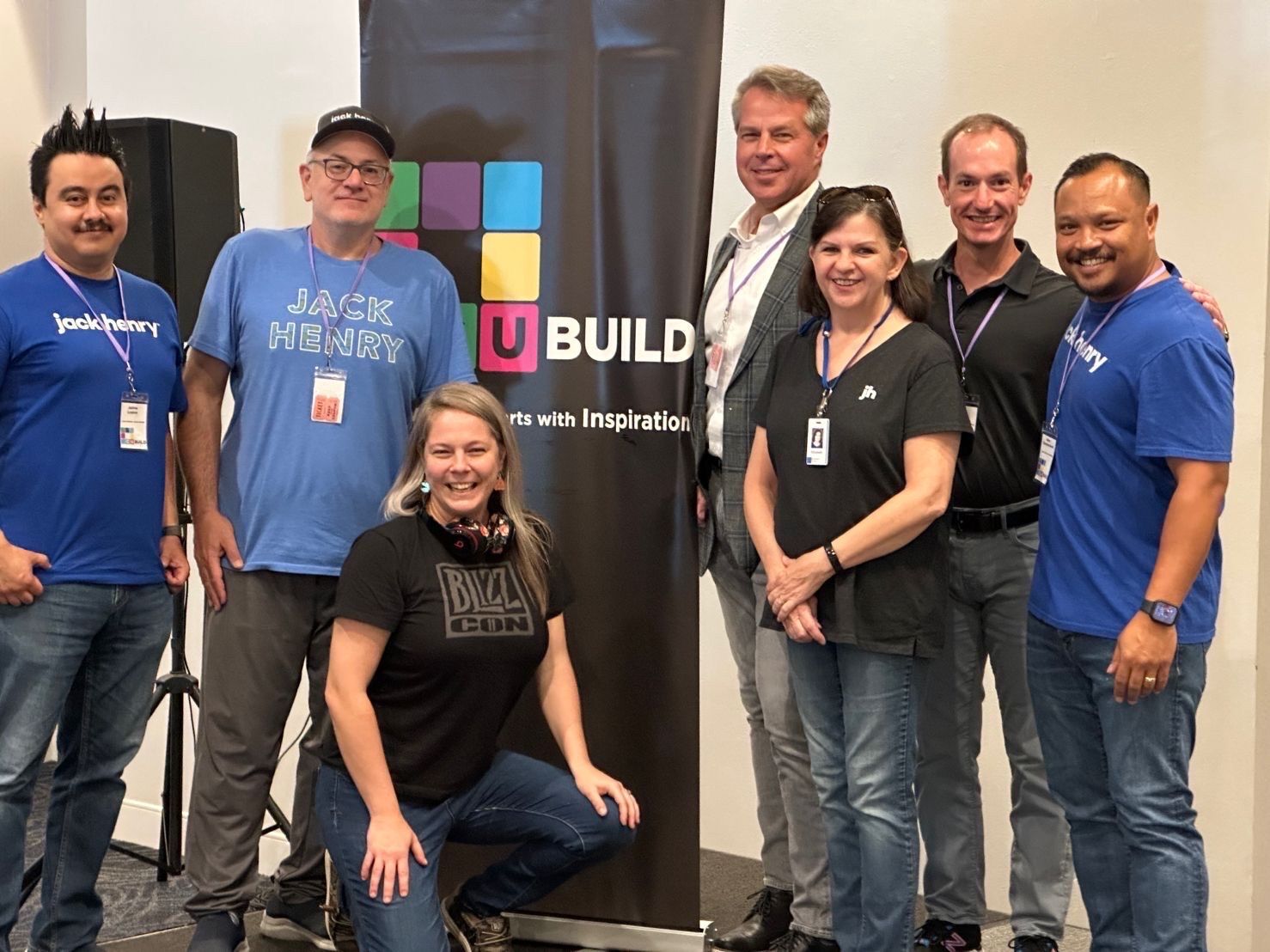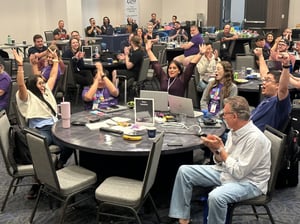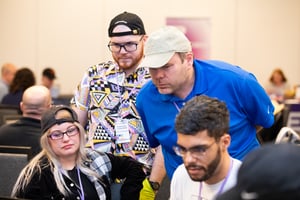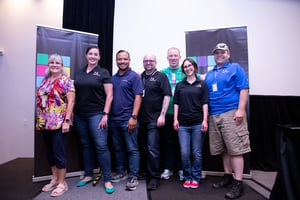
Picture it: Irving, Texas. July 2023.
More than 75 people are sitting in front of various types of technology – laptops, phones, tablets, and yes, even whiteboards and notebooks. Representing 29 credit unions, 11 vendors, and Jack Henry™, they’ve come to work together to solve real credit union problems with real tools to deliver innovative solutions in real time.
The hum in the air is electric – literally – because there are 70+ laptops plugged in, dissipating the heat of frenzied system processes competing for resources. Caffeine is flowing. Snacks, built in an elaborate design that can best be described as a nerd charcuterie, dwindle and get refilled as cheers of triumph ‒ along with slammed fists signifying yet another bug in the code ‒ filter through the ground floor of the hotel.
This is CU Build 2023, and just like last year’s event, it’s another one for the books.
What started as an idea stemming from an American Airlines Credit Union hack-a-thon has grown into an annual build-a-thon, organized with a mission of sparking innovation, cultivating learning, and fostering development in the credit union system. Credit unions using the Symitar® core system are invited to send participants, supported by various vendors and their contributors, to use the architectural and programmatic tools within the Jack Henry fintech ecosystem to design, program, execute, and present a solution to a problem facing the industry today. And the kicker? It has to be done in 36 hours.
annual build-a-thon, organized with a mission of sparking innovation, cultivating learning, and fostering development in the credit union system. Credit unions using the Symitar® core system are invited to send participants, supported by various vendors and their contributors, to use the architectural and programmatic tools within the Jack Henry fintech ecosystem to design, program, execute, and present a solution to a problem facing the industry today. And the kicker? It has to be done in 36 hours.
The first part of development – the forming – came from brainstorming and discussions on a group chat platform leading up to the event. The teams were allowed to share ideas but could do absolutely no coding until kickoff. Allowing the teams to digitally introduce themselves made the in-person icebreaker less awkward, as well as provided ways to continuously communicate and share code and announcements.
As logins were handed out to the CU Build environment, the teams were off to the races. “Wow, this has everything!” a participant exclaimed. “Where are the servers? Here at the hotel?”
Actually, they’re in Azure. Indeed, this feat of architecture makes a “Symitarian” swell with pride: CU Build’s mock credit union environment that contains the Jack Henry products a financial institution would need to run was built entirely in Azure, where the connectivity, security, scale, and effort clearly came to light. Almost 40 Jack Henry employees behind the scenes installed, loaded, tested, updated, and integrated a suite of Jack Henry tools; 16 business units worked together to get it completed in record time.
 As the forming merged to storming ‒ when excitement gives way to the frustrations of group problem-solving ‒ the boundaries of what these teams needed to do to bring their ideas to life were tested. Indeed, not every use case was in the environment, not every type of document existed, and standalone sandbox databases weren’t part of the original scope. All was overcome, though, and while concessions were made (with the grading rubrics in mind), the groups smoothly moved into the performing stage, where the teams started to really synergize and excel. Dr. Tuckman (a psychologist who studied group dynamics) would have been proud, as every group naturally divvyed up responsibility and the room got quiet, filled only with the sounds of pizza being munched, the staccato of backspace and enter keys being pressed, and the occasional sound of a password being reset.
As the forming merged to storming ‒ when excitement gives way to the frustrations of group problem-solving ‒ the boundaries of what these teams needed to do to bring their ideas to life were tested. Indeed, not every use case was in the environment, not every type of document existed, and standalone sandbox databases weren’t part of the original scope. All was overcome, though, and while concessions were made (with the grading rubrics in mind), the groups smoothly moved into the performing stage, where the teams started to really synergize and excel. Dr. Tuckman (a psychologist who studied group dynamics) would have been proud, as every group naturally divvyed up responsibility and the room got quiet, filled only with the sounds of pizza being munched, the staccato of backspace and enter keys being pressed, and the occasional sound of a password being reset.
What makes this initiative so unique is the diversity of the team members. From tech-savvy programmers to marketing specialists (and everyone else in between), every member of the team gets to be part of every stage of development and presentation, regardless of their current role, responsibilities, or skill set. Some folks have never written code and some have never presented in front of a live audience. For every veteran 10-year-plus Symitar experienced person is someone who just joined a credit union or has never worked on a development project before. This fishbowl concept of programming was back, for a weekend, to amazing results.
Hive mind programming isn’t new, but it certainly has taken a back seat to the conventional front-end versus back-end programming. In an effort to bring things as quickly as possible to market, we’ve evolved system enhancements to a rather extensive modularity that has developers picking sides: are you client-side or database? Front end or back end? Mountain Dew or Diet Mountain Dew?
All joking aside, separating engineering teams into these disciplines normally optimizes the output of teams: each area has its own distinct language set, skills, and knowledge necessary to be successful. In the case of CU Build, we bring them all together and challenge them to use their perceived weaknesses as strengths. And it’s the coming together of these unique viewpoints that levels up the end product, but is so rewarding for participants – both professionally and personally.
 The most amazing part of this is how safe everyone is: participants are safe to try a new language, a new integration, and a new way of moving data back and forth. Even the environment is safe. Where a developer might normally be terrified to “bring the system down,” Azure gave us the ability to roll back the clock if needed. (It wasn’t needed, but we still have life vests under our plane seats for a reason). Allowing programmers unfettered access to all aspects for the product development life cycle, including the individuals responsible for decisions and business cases, elevates cross-functional collaboration in a controlled and fast-paced way. They bring back to their day jobs the confidence and experience to continue such collaboration in their day-to-day projects.
The most amazing part of this is how safe everyone is: participants are safe to try a new language, a new integration, and a new way of moving data back and forth. Even the environment is safe. Where a developer might normally be terrified to “bring the system down,” Azure gave us the ability to roll back the clock if needed. (It wasn’t needed, but we still have life vests under our plane seats for a reason). Allowing programmers unfettered access to all aspects for the product development life cycle, including the individuals responsible for decisions and business cases, elevates cross-functional collaboration in a controlled and fast-paced way. They bring back to their day jobs the confidence and experience to continue such collaboration in their day-to-day projects.
Time doesn’t stand still, and most teams worked way into the overnight, taking shifts to rest, fuel up on soda and coffee, and collaborate. While the judges conferred on who the winners would be, rousing rounds of Family Feud and trivia – using ChatGPT, of course – had the participants together laughing off the last 36 hours of stress, panic, mighty successes, and setbacks. The best of CU Build was defined not only by the code the participants delivered, but by the connections they made.
Thirty-six hours isn’t that much time to create and deliver a working solution. But boy did the teams rise to the occasion! Amazing presentations focused on “Show Me The Data” – finding data in your system and then actionably using it for good. Financial wellness was the emergent theme throughout the submissions: the winning presentation focused on building credit scores through teen-secured loans, with a self-healing component that paid the loan off before it could become delinquent. Another used the JackHenry.dev toolkit with Banno to leverage custodial accounts so that online banking can share a child’s birthday and transfer money to their birthday fund. Credit union employees who often are the ones building the solutions of others were now building their solutions – ideas they were clearly proud of and passionate about.
As I boarded my plane to head back home, my phone rocking and rolling from the LinkedIn notifications for connections and messages, I realized that regardless of who wrote what code and presented what solutions, the CU Build mission also shared the impetus of the credit union movement as a whole: people helping people. I got to see vendors helping other vendors (even if it was “co-op-itition,” as it may be), clients helping clients, and even a little Jack Henry software support and ticket updates in the downtime. We all got a reminder that crossing the departmental aisle and collaborating outside the rigidity of corporate policies can bring some amazing good to those who benefit from such technological advances.
… As long as there is Mountain Dew.

Stay up to date with the latest people-inspired innovation at Jack Henry.
.svg)

Learn more about people-inspired innovation at Jack Henry.
Who We Serve
What We Offer
Who We Are